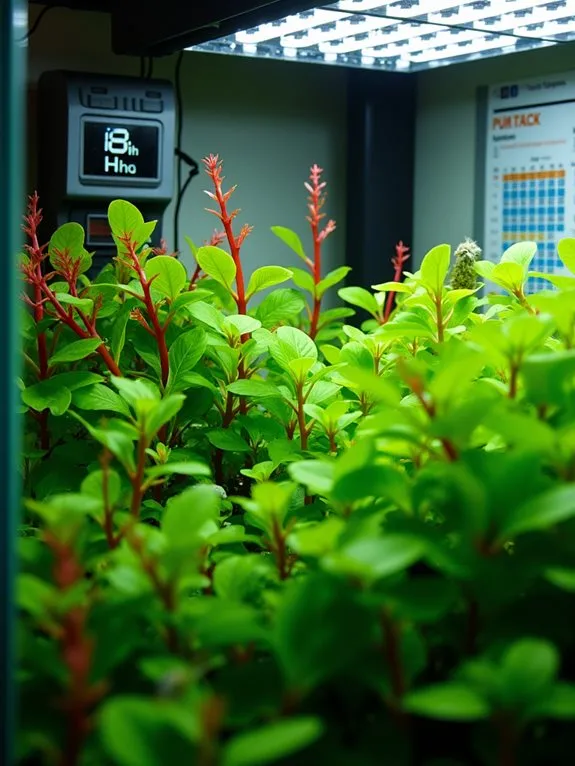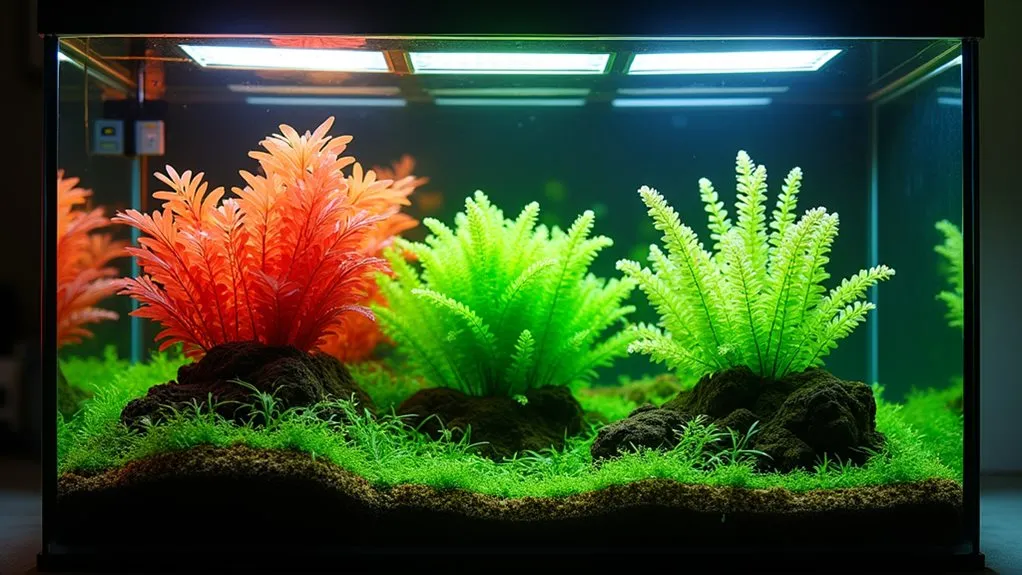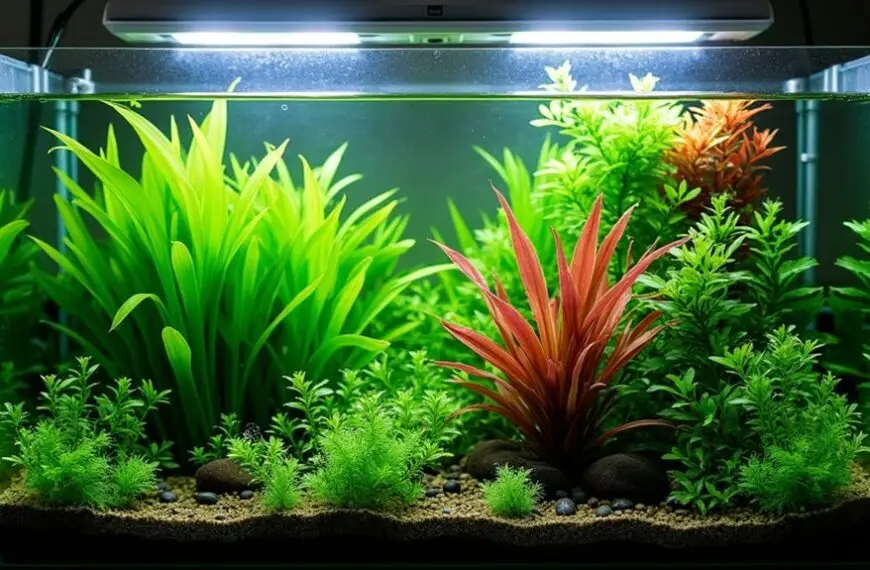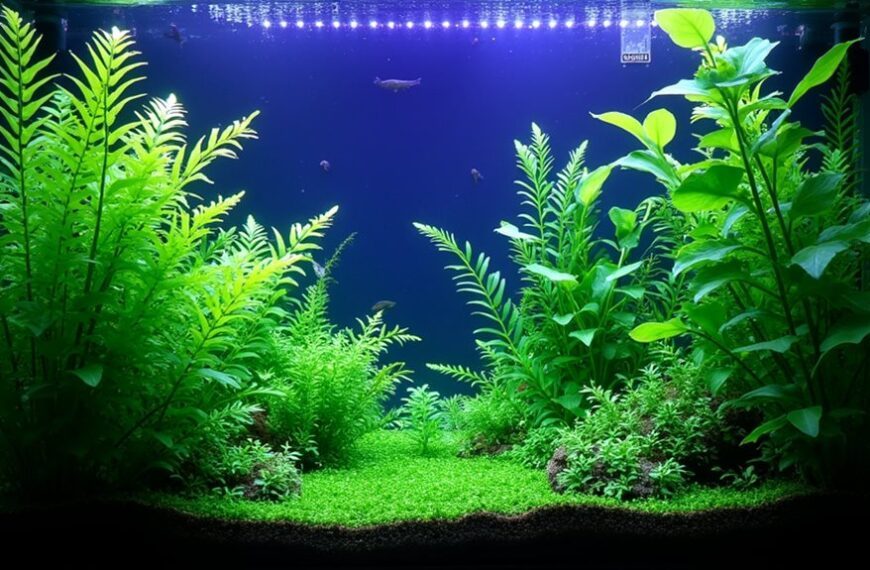For thriving aquarium plants, follow these three proven lighting tips: First, provide 8-10 hours of daily light using a timer to maintain consistency. Second, match light intensity to your plants’ needs—low-light varieties need 15-30 PAR while high-light species require 50+ PAR. Third, guarantee your light delivers the right spectrum with strong blue and red wavelengths for peak photosynthesis. Your underwater garden will reward your attention to these lighting fundamentals with lush, healthy growth.
Contents
- 1 Understanding Lighting Duration: Finding the Perfect Balance for Your Plants
- 2 Choosing the Right Light Intensity for Different Aquatic Plant Species
- 3 Implementing a Consistent Photoperiod Schedule for Healthy Growth
- 4 Frequently Asked Questions
- 4.1 Can LED Lights Grow Aquarium Plants Effectively?
- 4.2 How Do I Prevent Algae Growth When Increasing Plant Lighting?
- 4.3 Are Floating Plants Affected Differently by Aquarium Lighting?
- 4.4 Do Red Plants Require Special Lighting Considerations?
- 4.5 Should Lighting Be Adjusted During Medication or Water Treatments?
- 5 Final Thoughts
Understanding Lighting Duration: Finding the Perfect Balance for Your Plants
When it comes to keeping your aquarium plants healthy and thriving, lighting duration plays a crucial role that’s often overlooked. Most aquatic plants need between 8-10 hours of light daily, but finding your tank’s sweet spot requires observation and adjustment.
Watch how your plants respond to different durations. Too little light, and they’ll grow slowly or become leggy. Too much, and you’ll be fighting algae blooms! The light spectrum also matters—plants primarily use blue and red wavelengths for photosynthesis.
Try starting with 8 hours daily, then adjust based on plant response. Using a timer isn’t just convenient—it’s practically essential for consistency. Your leafy underwater friends rely on regular light cycles, just like you rely on your morning coffee!
Choosing the Right Light Intensity for Different Aquatic Plant Species
Now that you’ve mastered the timing of your tank’s light schedule, let’s talk about how bright those lights should actually be.
Different aquatic plant types need varying levels of intensity to thrive, and matching the right light to your plants is essential for success.
Light intensity is the secret language of aquarium plants – speak their brightness dialect for a truly flourishing underwater garden.
Here’s a quick guide to light intensity requirements:
- Low light plants (Anubias, Java Fern) – 15-30 PAR, perfect for beginners and shaded tank areas, these hardy species don’t need intense light spectrum coverage.
- Medium light plants (Crypts, Vallisneria) – 30-50 PAR, these versatile plants appreciate a balanced light spectrum with moderate intensity.
- High light plants (Carpeting plants, Red species) – 50+ PAR, these demanding beauties need powerful lighting with full spectrum coverage to develop vibrant colors.
Implementing a Consistent Photoperiod Schedule for Healthy Growth

Just as your fish need regular feeding, your aquatic plants thrive on a consistent light schedule. Effective photoperiod management means providing 8-10 hours of light daily, mimicking natural daylight cycles. Your plants will develop predictable growth patterns when they can “count on” regular light exposure.
Set timers to automate your light schedule, turning on in the morning and off in the evening. This consistency prevents stress that erratic lighting causes. Remember, too much light invites algae—your tank’s uninvited guest!
During vacations, don’t disrupt your established routine. Instead, invest in a simple timer to maintain consistency. Your plants don’t know you’re away, and they shouldn’t have to suffer for it!
With proper photoperiod management, you’ll enjoy lush, healthy plants that transform your aquarium into an underwater paradise.
Frequently Asked Questions
Can LED Lights Grow Aquarium Plants Effectively?
Yes, LED lights can grow aquarium plants effectively. You’ll appreciate their efficiency while providing the right light spectrum for photosynthesis. They’re cost-effective, long-lasting, and can be tailored to your plants’ specific needs.
How Do I Prevent Algae Growth When Increasing Plant Lighting?
You’ll limit algae growth by controlling your lighting duration to 8-10 hours daily. Don’t overdo it! Balance nutrients, add fast-growing plants, and consider algae eaters for effective algae control in your aquarium.
Are Floating Plants Affected Differently by Aquarium Lighting?
Yes, floating plants are affected differently by aquarium lighting. You’ll notice they’re closer to light sources, absorbing more light intensity. This gives you floating plant benefits like natural algae control through efficient light absorption.
Do Red Plants Require Special Lighting Considerations?
Yes, your red plants require special lighting considerations. They need higher intensity light with a spectrum rich in blue and red wavelengths to maintain their vibrant coloration and healthy growth patterns.
Should Lighting Be Adjusted During Medication or Water Treatments?
Yes, you should reduce your lighting during medication treatments. Some medications can increase light sensitivity, and treatment effects may cause stress to plants. You’ll protect your aquatic plants by limiting light exposure temporarily.
Final Thoughts
You’ve now got the tools to create a thriving underwater garden! Remember, finding the right lighting balance isn’t rocket science—it’s about patience and observation. Start with these three lighting principles, adjust as needed, and watch your aquatic plants flourish. Don’t worry if you make mistakes along the way; that’s part of the journey. Your beautiful, healthy aquarium is just a few light adjustments away!












